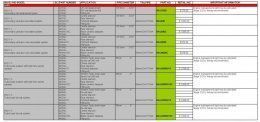- Joined
- Feb 21, 2013
- Messages
- 408
- Reaction score
- 390
- Points
- 63
- Location
- Westbury, originally from Leeds

Did you have to remap having removed cats? And what kind of power gain does this give?
Regards Bob

Proper job Neil, I'll post this now for others...
1) Using a 13mm ring spanner carefully remove the 6-nuts holding the cat-pipes to the down pipes
Make sure to spray the studs with WD40 or similar lubricant as the studs are mild steel and secured to the cat-pipes
2) Using a 13mm ring spanner release the 4-nuts from the connecting-sleeves securing the cat-pipes to the primary silencer
3) Carefully slide each connecting-sleeve forward and onto its respective cat-pipe
4) Carefully remove both cat-pipes with the gaskets and the connecting sleeves
5) Carefully remove the metal gaskets from the cat-pipes: use a thin broad blade or similar so as not to damage the gaskets
6) You'll have noticed that the nuts on the connecting-sleeves were uppermost when you removed them; this is not good engineering practice as if the nut were to unscrew then the likelihood is that you'd loose both the nut and the screw so, when refitting, change the connecting-sleeves over so that the nuts are on the underside (hope this makes senseâ¦)
7) Slide the original nearside connecting-sleeve onto the offside bypass pipe (securing nuts down)
8) Using the original metal gasket without sealant, assemble the offside bypass pipe to the offside down pipe: use stainless steel nuts and bolts where possible and make sure to coat the threads of ALL bolts with Copperslip or similar anti-seize grease
9) Slide the connecting-sleeve on to the offside primary silencer pipe and pinch tighten both nuts and bolts (make sure you've applied Copperslip to the threads)
10) Keep checking the alignment and tighten all 5-nuts and bolts to complete
11) Use exactly the same procedure (7 to 10) and assemble the nearside bypass pipe
12) Double check alignments and tightness of the fastenings
The tools:


Well i had a nice little drive yesterday that involved a spirited section or 2.
I don't know whether this is just a physcological response to the extra sound, but it definately feels like it rev's better, more crisper and slightly faster (Again it could be just in my head........Mark step in anytime and disect me).
So round town, no real noticable difference, but open her up and a definate deeper growl and a more pronounced "BRRRUUPP" on the upshift when pressed hard.
Verdict, not an expensive option but gives a pleasing result. VFM.


Well i had a nice little drive yesterday that involved a spirited section or 2.
I don't know whether this is just a physcological response to the extra sound, but it definately feels like it rev's better, more crisper and slightly faster (Again it could be just in my head........Mark step in anytime and disect me).
So round town, no real noticable difference, but open her up and a definate deeper growl and a more pronounced "BRRRUUPP" on the upshift when pressed hard.
Verdict, not an expensive option but gives a pleasing result. VFM.

I am glad you lot have seen the light with the secondary CAT bypass....I feel somewhat responsible

Pipes fitted today, brilliant mod! Much better note! On both up and downshifts!!
Surely you aren't going to tell your insurance company you have an illegal modification...?[/QUOT
illegal mod ?
I've kept mine and will refit the OEM system before selling the car, eventually. I declared the minor mod to my insurance company and it was not an issue. Audi haven't noticed/haven't mentioned it...

